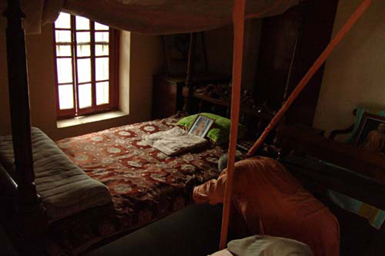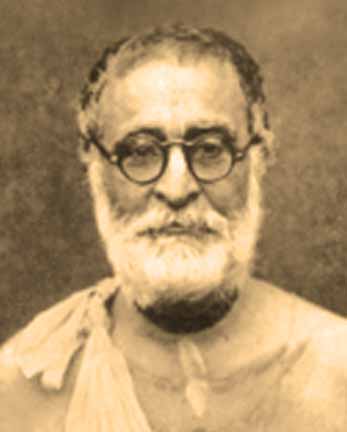

Srila Bhaktisiddhanta Sarasvati Thakur Prabhupada, (February 6, 1874 – January 1, 1937), was a preacher of Gaudiya Vaishnavism throughout India in the late nineteenth and early twentieth century. He was born as Bimal Prasad Dutta in the seaside pilgrimage town of Jagannath Puri, Orissa, India. His father was the Vaishnava scholar Sri Kedarnath Dutta, later known as Bhaktivinoda Thakur, the first to present the teachings of Chaitanyite Vaishnavism to the English speaking world and was a notable Gaudiya Vaishnava Theologian. Prasad was well-known for having a fiery preaching spirit and especially acute intellect.
Background

By the time he was twenty-five years old, Bimala Prasada had acquired an impressive reputation as a scholar of Sanskrit, mathematics, and astronomy. Editing the publication of an ancient astronomical treatise, Surya Siddhanta, won the title Siddhanta Sarasvati recognition of his scholastic achievements. In 1905, following the advice of his father, Siddhanta Sarasvati accepted spiritual initiation from Gaurakisora dasa Babaji. Although Gaurakisora dasa Babaji was renowned as a saintly person and great devotee of Krishna, he was illiterate and left no scriptural additions to the tradition of Vaishnava Theology. Satisfied with the humility and dedication of his highly educated disciple, Srila Gaurikisora gave him his full blessings and requested him to "preach the Absolute Truth and keep aside all other work." Siddhanta Sarasvati then proved himself a capable assistant in the missionary work of his father. Here, one has to understand the secret of his divine birth. His father was praying desperately to Lord Jagannatha to send one who could help him in preaching the message of Lord Chaitanya. His birth and preaching activities were predicted in the Padma Purana long ago.
Gaudiya Math

From the very beginning of Chaitanya's bhakti movement in Bengal, Haridasa Thakur and others Muslim or Hindu by birth were the participants. This openness received a boost from Bhaktivinoda Thakura's broad-minded vision in the late nineteenth century and was institutionalized by Bhaktisiddhanta Sarasvati in his Gaudiya Math in the twentieth century.
Upon the death of Bhaktivinoda Thakura in 1914, Siddhanta Sarasvati became editor of his father's journal, Sajjana-tosani, and founded the Bhagwat Press for publication of Vaishnava literature. Then in 1918, Siddhanta Sarasvati accepted the renounced order of spiritual life, assuming the title Srila Bhaktisiddhanta Sarasvati Goswami Maharaja. For the purpose of propagating Krishna-bhakti throughout India, he organized the Gaudiya Math, with sixty-four branches throughout the country. The headquarters of his mission, the Caitanya Gaudiya Math, was located in Sridhama Mayapur, the birthplace of Lord Caitanya. He would later send disciples to Europe for missionary work.
There has not been, there will not be, such benefactors of the highest merit as Chaitanya Mahaprabhu and His devotees have been. The offer of other benefits is only a deception; it is rather a great harm, whereas the benefit done by Him and His followers is the truest and greatest eternal benefit. This benefit is not for one particular country, causing mischief to another; but it benefits the whole universe.
—Siddhanta Sarasvati
Bhaktisiddhanta Sarasvati Thakur is also the spiritual master of world renowned A.C Bhaktivedanta Swami Prabhupada. It was A.C Bhaktivedanta Swami Prabhupada who set out in 1965, at the age of 69, to America to try and fulfil the admonition of Bhaktisiddhanta Sarasvati Goswami Maharaja of preaching to the West. Within 12 years A.C Bhaktivedanta Swami Prabhupada had set up a world wide society of devotees of Lord Krishna and Lord Chaitanya Mahaprabhu (called ISKCON)- and fulfilled the prophecy of Lord Chaitanya. Not only that, A.C Bhaktivedanta Swami Prabhupada established 108 centres world wide (personally traveling to USA, England, Scotland, Germany, France, Hawai, Russia, Australia, South Africa, Nigeria, Japan and many other countries.) He also made "Hare Krishna" a house-hold term in the USA, translated texts into English and gave purports to various Sanskrit Vedic texts (approaching 70 volumes) such as the Bhagavad-Gita and Srimad Bhagavatam - allowing thousands to benefit from learning these valuable ancient teachings. A.C Bhaktivedanta Swami Prabhupada had accomplished what Srila Bhaktisiddhanta Sarasvati Goswami Maharaja and his father Bhaktivinoda Thakur had so long desired - an international society of Krishna conscious devotees.
Modern application of Bhakti

Bhaktisiddhanta Sarasvati adjusted the traditions of Gaudiya Vaishnavism to conform with the technological and social conditions of the twentieth century. He considered the printing press the most effective means of spreading Krishna Consciousness throughout the world and was himself the author of many important translations, commentaries, and philosophical essays
Bhaktisiddhanta Sarasvati was a highly influential preacher of Gaudiya Vaishnavism throughout India in the late 19th and early 20th Century. He was born as Bimala-prasad Dutta in the pilgrimage town of Jagannatha Puri, Orissa, India. His father was the Vaishnava scholar Sri Kedarnatha Dutta (also known as Bhaktivinoda Thakura) the first to present the teachings of Chaitanyite Vaishnavism to the English-speaking world and was a notable Gaudiya Vaishnava Theologian. Bimala Prasada was well known for having a fiery spirit, an acute intellect and for living a simple, austere lifestyle.
By the time he was twenty-five years old, Bimala-prasada had acquired an impressive reputation as a scholar of Sanskrit, mathematics, and astronomy. His astronomical treatise on the ‘Surya Siddhanta’ won him the title Siddhanta Sarasvati in recognition of his immense learning. In 1905, following the advice of his father, Siddhanta Sarasvati accepted spiritual initiation from Gaura-kisora Dasa Babaji. Siddhanta Sarasvati proved himself a capable assistant in the missionary work of his father.
Upon the passing of Bhaktivinoda Thakura in 1914, Siddhanta Sarasvati became editor of his father's journal, ‘Sajjana-tosani’, and founded the Bhagavata Press for publication of Vaishnava literature. Then in 1918, Siddhanta Sarasvati accepted the order of sannyasa (renounced order of life), assuming the title ‘Bhaktisiddhanta Sarasvati’. For the purpose of propagating the philosophy of Caitanya Mahaprabhu throughout India, he organized a mission called the Gaudiya Matha, with sixty-four branches throughout the country. The headquarters of the Gaudiya Matha, Sri Chaitanya Matha, was located in Mayapura, the birthplace of Caitanya Mahaprabhu.
Bhaktisiddhanta travelled the length and breadth of India - from Bengal to Orissa, to South India to Uttar Pradesh. During his many travels he met with kings, scholars, politicians, religious leaders, philsophers, British aristocracy and scientists.Some of the people he spoke with are listed below:
1. Sir John Anderson (Governor of Bengal)
2. Sir William Malcolm Hailey (Governor of the United Provinces)
3. Sir George Fredrick Stanley (Governor of Madras)
4. Virvikramkisor Devavarma Manikya Bahadur, the Maharaja of Tripura
5. Maharaja Krishnaraj Wodayar, king of Mysore State
6. Indira Devi (Queen of Cochbihar)
7. Prof. Albert E. Suthers of Ohio State University
8. Mr. Willion Henri Jan Vandor Stok of Batavia
9. Mrs. Nora Morell of Germany
10. Dr. Magnus Hirschfield of Berlin (a renowned psychologist)
11. Prof. Dr. Stella Kramrisch, M.A., Ph.D
12. Prof. Johans of St. Xaviers College
13. Satyadhanya Tirtha Swamiji of Uttaradi Math
14. Vasudeva Ramanuja of Embar Math, Ouri
15. General Punya Samaser Rana Jambahadur of Nepal
16. Pandit Madan-mohan Malavya
17. Dr. Ganganath Jha (Vice Chancellor of Allahabäd University)
18. Dr. Kalidas Nag (famous historian and professor at the University of Calcutta)
19. Dr. Dinesh Chandra Sen (famous writer and professor at the University of Calcutta),
20. Sri Janakinatha Bose (famous advocate and father of Subhash Chandra Bose)
21. Sri Birajmohan Mukhopadhyaya (Vice Principal of the Law College of the University of Calcutta)
22. Col. Dwaraka Prasad Goel (Principal of Calcutta Medical College)
23. Prof. K. Panchapagesan of Purukote College in Madras
24. Dr. Suniti Chatterjee of the University of Calcutta
25. Sri Ganesh Chandra Chanda (Superintendent of the Archaeological Division of Bihar)
26. Sri Khagendra Nath Mitra (Professor at Presidency College, Calcutta)
27. Mme. Maximiani Portas (French scholar)
Bhaktisiddhanta Sarasvati adjusted the traditions of Gaudiya Vaishnavism to the technological and the social condition of the twentieth century. He considered the printing press the most effective means of spreading Chaitanyite teachings throughout the world and was himself the author of many important translations, commentaries, and philosophical essays. In the early 30’s he sent some of his disciples to Europe for missionary work. This was revolutionary in the eyes of orthordox Hinduism as traditionally monks were not supposed to cross the ocean. Bhaktisiddhanta Sarasvati also implemented other innovations such as using automobiles and dressing his followers in British clothes in order to preach to the English aristocracy. One of the most controversial activities of Bhaktisiddhanta Sarasvati was his awarding the sacred thread to those that were not born as brahmanas. Many born brahmanas challenged him on this but using references from the Vedic scriptures he defeated all his opponents.
During his lifetime Bhaktisiddhanta wrote the following books:
'Bange samajikata' - a short work on various religious groups and philosophies in Bengal published in 1890.
'Brahmana o Vaishnaver Taratamya Visayaka Siddhanta' ('The Conclusion on the Comparison Between Brahmanas and Vaishnavas') An essay based on a famous lecture given by Bhaktisiddhanta at Midnapore. This book was published in 1911.
'Prakrta Rasa Sata Dusini' ('A Hundred Warnings Against Mundane Mellows') published in 1916
'Vaisnava Ke' (What Type of Vaishnava are You?) - a short Bengali poem of 19 verses describing the proper attitude of a follower of Chaitanya.
Bhaktisiddhanta also wrote commentaries to the most important books of the Gaudiya canon. Some of these include:
Commentary on Srimad Bhagavatam
Commentary on Chaitanya-bhagavata
Anubhasya commentary on Caitanya-caritamrta
Anuvrtti Commentary on Upadesamrta
Siksastakam vivrti commentary on Siksastakam
Additionally, hundreds of his discourses of were transcribed regularly by his followers and printed in the following periodicals published by the Gaudiya Matha:
The Harmonist (a fortnightly periodical in English)
The Gaudiya (in Bengali)
Sajjana-tosani (in Bengali)
Kirtana (in Assamese)
Paramarthi (in Oriya)
Bhagavata (in Hindi)
Bhaktisiddhanta also published a daily newspaper called 'Nadiya Prakash' from his center in Calcutta.
Bhaktisiddhanta's Gaudiya Matha published works by Bhaktivinoda Thakura, the Six Goswamis, Narottama Dasa Thakura and other teachers of the Gaudiya Vaishnava lineage. Some of the most important works he published include 'Jaiva-dharma', 'Harinama-chintamani', Prema-bhakti-chandrika', 'Bhakti-rasamrta-sindhu', and both Gita commentaries by Vishvanatha Chakravarti and Baladeva Vidyabhusana.
Bhaktisiddhanta Sarasvati was renowned for his bold stance against all false philosophies and pseudo-spiritual groups – especially those that posed themselves as followers of Chaitanya Mahaprabhu. Bhaktisiddhanta Sarasvati’s role in the Gaudiya Vaishnava movement of the 20th century should not be underestimated.
No comments:
Post a Comment